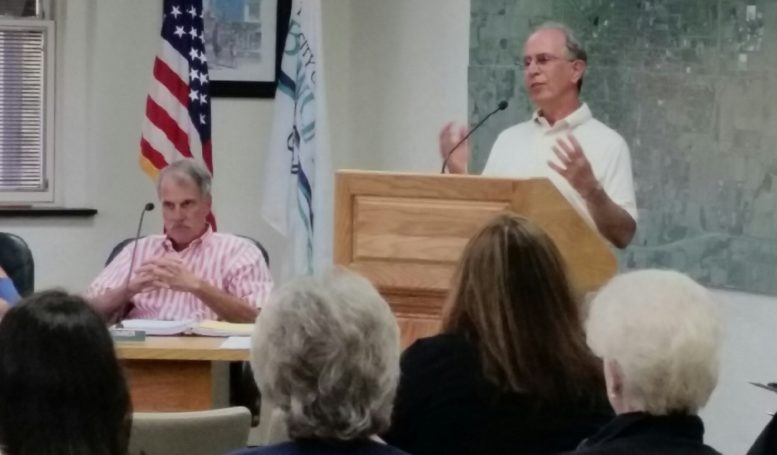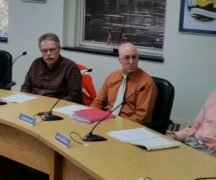By JAN LARSON McLAUGHLIN
BG Independent News
Bowling Green officials are tired of getting the brush off by the Nexus pipeline, by the Ohio EPA, and by the Federal Energy Regulatory Commission.
But it appears that getting anyone in authority to listen may take more money than the city can afford – and even then the results are not guaranteed.
The major concern is that the 36-inch high-pressure natural gas line will be located close enough to the city’s water treatment plant along the Maumee River, that any accidents could have horrific consequences to the water quality.
The city has called in experts and sent letters expressing concerns to many state and federal officials. During City Council meeting Monday evening, Mayor Dick Edwards held up files of information he had collected on the pipeline issue.
“This is enough to choke a horse,” he said of all the paperwork.
“I take it all very seriously,” Edwards said. “I’m frankly, not giving up at all.”
Other efforts are underway to plug the pipeline project. A citizens group is currently collecting signatures to get a charter amendment to protect Bowling Green from the pipeline on the November ballot. (A story on that petition effort will appear later this week on BG Independent News.)
Brad Holmes, president of the BGSU Environmental Action Group, who is coordinating the charter amendment effort, asked city officials Monday to file a motion to intervene with FERC. He referred to the Nexus pipeline as a “potential source of disaster.”
Neocles Leontis suggested the city also try a different route of asking the Ohio EPA to withhold approval of a water quality certification and isolated wetlands permit unless the pipeline is rerouted.
“There is something you can do,” he said. However, since a decision on the pipeline is expected in August, “there’s not a lot of time to act.”
Leontis urged officials and citizens to contact “heavy hitters,” like U.S. Rep. Bob Latta, State Sen. Randy Gardner, and State Rep. Theresa Gavarone, all R-Bowling Green. “We need to pull out all the stops.”
“This is their chance to show that our well being” is their top priority, he said.
The mayor has written a letter listing all the problems with the pipeline route, Leontis said. Yet it has had no impact.
“They’ve not made the least effort to reroute it,” he said of the pipeline.
Jennifer Karches suggested that the city ask FERC to re-evaluate the environmental survey for the pipeline, since it ignored the existence of the Bowling Green fault line, the nearby blasting quarry, and the close proximity to the city’s water plant.
“Residents of Bowling Green want to see every reasonable action taken to protect the Bowling Green water treatment plant,” Karches said.
But it appears that filing a motion to intervene may not be seen as “reasonable” by city officials who have to stay within a budget.
Council president Mike Aspacher said the motion was a matter of “ongoing discussion,” but no decision had been made.
Karches said the city shouldn’t delay too long. “We need to take some action,” she said.
But Edwards explained that while filing a motion to intervene is not a complicated or costly process, it would quickly become quite expensive. “It’s what comes after that,” he said.
Edwards said he has talked with the mayor of the city of Green, in northeastern Ohio, where the pipeline is proposed to bisect the city. That city has set aside $150,000 for legal fees for its intervention request. Meanwhile, the pipeline companies have much deeper pockets.
The mayor of Green shared his frustration with unresponsive Ohio EPA officials. Edwards said he has sent requests to speak with Ohio EPA officials, but has heard nothing in return – not even a form letter.
Council member John Zanfardino asked about the value of filing a motion to intervene, as recourse in case a problem occurs with the pipeline.
But Bowling Green Solicitor Mike Marsh explained that while filing is cheap, the process doesn’t stop there.
“You don’t get to intervene in a case and then leave” when it gets too expensive, Marsh said. “Federal judges don’t like that.”
Once the city were to file, “that means you participate from then on. That’s a significant financial commitment that I can’t recommend,” Marsh said, estimating it would cost between $150,000 and $250,000.
“I don’t have that in my budget,” he said. And Marsh said he has been told the likelihood of the city winning is slim. “You’ll spend $250,000 on this, but you won’t win.”
A less expensive option would be to have a law firm file the motion, rather than the city – though that would carry less weight. That would cost closer to $15,000. “To be honest, I don’t have that in my budget either,” Marsh said.
Marsh shared his frustration at not getting Ohio EPA or Nexus pipeline officials to talk. Council member Bruce Jeffers asked about the possibility of getting Nexus to do more study of the environmental risks.
“They’re just waiting for FERC” to rule on the pipeline route and see no reason to respond to local concerns, Marsh said.
Jeffers asked if the city could pay for its own tests. Marsh said drilling tests could be done on city’s land where the pipeline is proposed to pass. But the costs are unknown.
“Can you really put a price tag on water,” Holmes said.
Marsh noted the amount of money Bowling Green has put into water treatment plant improvements. “We’re really interested in protecting it,” he said.





